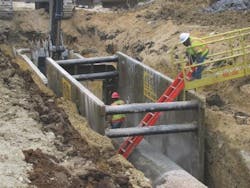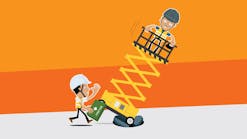Excavation and trenching are considered two of the most dangerous construction operations by the Occupational Health and Safety Administration, and the governmental agency cites numerous contractors for infractions every month. Occasionally, a trench collapse claims the life of a worker.
OSHA has published a Fact Sheet addressing trenching and excavation safety and specifically notes the need for protective systems in order to ensure the safety of those working in an excavation or trench.
What are the three types of protective systems?
OSHA identifies three basic types of protective systems: shielding (devices designed to protect workers in the event of a collapse, such as trench boxes); shoring (bracing designed to prevent collapse, such as hydraulic shoring or slide-rail systems); and sloping or benching trench walls away from the trench bottom at a safe angle.
OSHA gives a pass on trench protection only in two instances: 1) when “excavations are made entirely in stable rock” or 2) when “excavations are less than 5 feet in depth and examination of the ground by a competent person provides no indication of a potential cave-in.”
Sloping/benching is permissible for excavations less than 20 feet deep, with the angle of the slope or bench determined by soil type, whether A, B, or C. (See Subpart P, Appendix A and B for details.) The less stable the soil, the shallower the angle. Sloping/benching for excavations deeper than 20 feet must be designed by a registered professional engineer.
Some contractors make the point that sloping trench walls can involve moving a significant amount of extra material that must be stockpiled and excavated a second time when backfilling; they advise considering the economics of doing so against the cost of alternative protective systems, assuming that safety is equally addressed with all the viable options.
Mike Ross, national training director for Efficiency Production, a manufacturer of trench boxes and shoring systems, makes the point that OSHA’s Subpart P is a performance-based standard, giving the competent person parameters to follow, rather than specific directives.
What is Subpart P?
This means, he says, that the competent person can select the protective system best suited to site conditions, as long as the competent person can demonstrate the safety of the system upon request—and can show that the system is being used in accordance with the system manufacturer’s tabulated data. (Tabulated data include tables and charts, approved by a registered engineer, that govern the use of a particular system.) For instance, a particular trench shield might be rated safe for use to depths of 8 feet, but using it at 15 feet exceeds limitations stated in the tabulated data and places workers at risk.
“Probably 80 percent of all projects can be handled with trench boxes,” says Ross. “This is usually the fastest method of placing pipe. When a box can’t be used, then you choose the best alternative, whether slide-rail, sheeting frames, or hydraulic shores. The choice is dictated by the project and site conditions.”
Jim Mclaughlin, safety officer, field, for William A. Hazel, Inc. a site-development and road-construction contractor in northern Virginia, notes some of the considerations involved when selecting a protective system.
“The work area primarily dictates the type of trench safety actions we take,” says Mclaughlin. “Is there adequate space to slope the sides of the trench to 1½ to 1? What type of soil is encountered? Are utilities or other obstructions present that would prevent sloping or use of a trench box? Will the work take place near a roadway? These are some of the considerations regarding trench safety.”
Safety consultant Wood notes that Subpart P requires that underground utilities be removed, supported, or protected, as necessary. “Some contractors will use a shield in these situations, because that’s what they normally use,” says Wood. “A shield, however, unless used with great care, might not provide proper support of the utility. In these instances, a soil-support system that is actively holding soil in place and not allowing it to move out from under a parallel gas or water line might be the best way to meet the OSHA requirement.”
Other cautions to be observed when using trench shields, says Wendell Wood, an excavation-safety consultant and trainer, is to avoid over-cutting and allowing the shield to move laterally in the trench—and also to avoid allowing material to spill over the top of the shield by leaving a vertical wall above the shield.





